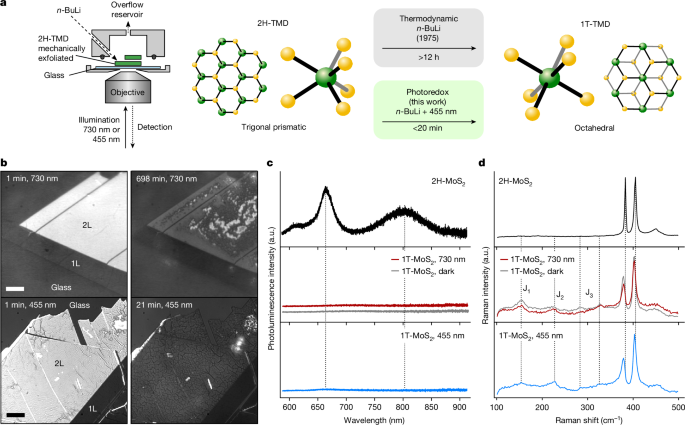approfondimento - Materials Science - # Photoredox-driven Phase Transition in 2D Transition Metal Dichalcogenides
Accelerating Phase Transition in 2D Transition Metal Dichalcogenides through Photoredox Engineering
Concetti Chiave
Illumination at 455 nm can accelerate the phase transition from semiconducting 2H to metallic 1T phase in 2D transition metal dichalcogenides by up to six orders of magnitude, enabled by a photoredox process that improves the rate-limiting charge-transfer kinetics.
Sintesi
The content discusses the use of photoredox engineering to accelerate the phase transition in two-dimensional transition metal dichalcogenides (2D TMDs) from the semiconducting 2H (trigonal) phase to the metallic 1T (octahedral) phase. This phase transition is typically achieved through chemical lithiation using the organometallic agent n-butyllithium (n-BuLi), but the underlying mechanisms are poorly understood, and the use of n-BuLi raises safety concerns.
The authors demonstrate that illumination at 455 nm can accelerate this phase transition by up to six orders of magnitude. They identify that the above-gap illumination improves the rate-limiting charge-transfer kinetics through a photoredox process. This method allows for rapid and high-quality phase engineering of TMDs, enabling the inscription of arbitrary phase patterns with diffraction-limited edge resolution into few-layer TMDs.
Furthermore, the authors replace the pyrophoric n-BuLi with safer polycyclic aromatic organolithiation agents, which exhibit superior performance as phase transition agents compared to n-BuLi. This work opens up opportunities for in situ characterization of electrochemical processes and paves the way for sustainable scaling up of materials and devices through photoredox phase engineering.
Photoredox phase engineering of transition metal dichalcogenides - Nature
Statistiche
Illumination at 455 nm can accelerate the phase transition from 2H to 1T phase in 2D TMDs by up to six orders of magnitude.
The use of safer polycyclic aromatic organolithiation agents as phase transition agents exceeds the performance of n-BuLi.
Citazioni
"Here we optically visualize the archetypical phase transition from the 2H to the 1T phase in mono- and bilayer 2D TMDs and discover that this reaction can be accelerated by up to six orders of magnitude using low-power illumination at 455 nm."
"We use this method to achieve rapid and high-quality phase engineering of TMDs and demonstrate that this methodology can be harnessed to inscribe arbitrary phase patterns with diffraction-limited edge resolution into few-layer TMDs."
Approfondimenti chiave tratti da
by Juhwan Lim,J... alle www.nature.com 08-28-2024
https://www.nature.com/articles/s41586-024-07872-5
Domande più approfondite
How can the insights from this photoredox-driven phase transition be applied to other 2D materials beyond TMDs?
The insights gained from the photoredox-driven phase transition in TMDs can be extended to other 2D materials by leveraging similar optical manipulation techniques to induce phase transitions. By understanding the mechanisms that govern the phase transition process in TMDs, researchers can explore applying similar principles to other 2D materials, such as graphene, transition metal oxides, or MXenes. This approach could enable the controlled tuning of the physical and electronic properties of a wide range of 2D materials, opening up new possibilities for tailored applications in electronics, catalysis, and energy storage.
What are the potential limitations or drawbacks of using polycyclic aromatic organolithiation agents as phase transition agents compared to n-BuLi?
While polycyclic aromatic organolithiation agents offer a safer alternative to pyrophoric n-BuLi for phase engineering in 2D materials, there are potential limitations and drawbacks to consider. One limitation is the efficiency of the phase transition process, as the performance of polycyclic aromatic organolithiation agents may not match that of n-BuLi in terms of speed and effectiveness. Additionally, the availability and cost of these alternative agents could be higher, impacting the scalability and practicality of large-scale applications. Furthermore, the compatibility of polycyclic aromatic organolithiation agents with different 2D materials may vary, leading to challenges in achieving consistent and reproducible phase engineering results across a diverse range of materials.
What other types of light-driven processes could be leveraged to engineer the properties of 2D materials in a controlled and scalable manner?
In addition to photoredox processes, other light-driven techniques can be harnessed to engineer the properties of 2D materials in a controlled and scalable manner. One approach is photothermal processing, where light is used to induce localized heating in the material, leading to phase transitions or structural modifications. Photocatalytic reactions can also be employed to drive chemical transformations in 2D materials under light irradiation. Furthermore, photonic patterning techniques, such as laser ablation or photolithography, can be utilized to create precise patterns or structures in 2D materials, enabling tailored property engineering. By exploring a combination of these light-driven processes, researchers can achieve versatile and efficient methods for controlling the properties of 2D materials for various applications.
0
